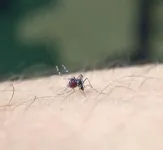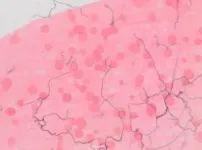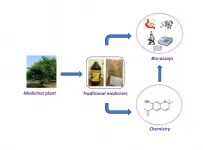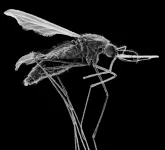Asian tiger mosquito poses low risk for Zika virus outbreaks
2021-01-02
(Press-News.org) The Asian tiger mosquito does not pose a major risk for Zika virus epidemics, according to a study published December 31 in the open-access journal PLOS Pathogens by Albin Fontaine of the Institut de Recherche Biomédicale des Armées, and colleagues.
Zika virus has triggered large outbreaks in human populations, in some cases causing congenital deformities, fetal loss, or neurological problems in adults. While the yellow fever mosquito Aedes aegypti is considered the primary vector of Zika virus, the Asian tiger mosquito Aedes albopictus has been shown experimentally to transmit the virus and was involved in several transmissions of the virus in France in 2019. Originating from Southeast Asia, Ae. aegypti is an aggressive biter that has invaded the world and is now present on all inhabited continents, including temperate Europe, due to its ability to endure harsh winter conditions. As the second most important vector of human viral pathogens, Ae. albopictus is displacing Ae. aegypti populations due to competitive advantages. But it is not known if Ae. albopictus could trigger large-scale Zika virus epidemics.
To address this question, the researchers exposed Ae. albopictus to Zika virus and assessed infection rates in experiments, modeled the dynamics of Zika virus infection within individual humans, and used epidemiological simulations. The highest risk of transmission occurred during the pre-symptomatic stage of the disease. At this dose, mosquito infection probability was estimated to be 20%, and 21 days were required to reach median systemic infection rates. Despite these unfavorable characteristics for transmission, Ae. albopictus was still able to trigger large outbreaks in a simulated environment in the presence of sufficiently high mosquito densities and biting rates. According to the authors, active surveillance and eradication programs should be implemented in territories occupied by Ae. albopictus to maintain the low risk of Zika virus outbreaks.
The authors conclude, "The complementary combination of dose-dependent experimental infection, modeling of intra-human viremia dynamics, and in silico epidemiological simulations confirms the low epidemic potential of Aedes albopictus for Zika virus."
INFORMATION:
Peer-reviewed; Situation / modeling; Experimental study; Animals; Cells
In your coverage please use this URL to provide access to the freely available article in PLOS Pathogens:
http://journals.plos.org/plospathogens/article?id=10.1371/journal.ppat.1009068
Citation: Lequime S, Dehecq J-S, Matheus S, de Laval F, Almeras L, Briolant S, et al. (2020) Modeling intra-mosquito dynamics of Zika virus and its dose-dependence confirms the low epidemic potential of Aedes albopictus. PLoS Pathog 16(12): e1009068.
https://doi.org/10.1371/journal.ppat.1009068
Funding: This study was funded by the Direction Générale de l'Armement (https://www.defense.gouv.fr/dga, grant no PDH-2-NRBC-2-B-2113, SB) and the Direction Centrale du Service de Santé des Armées (https://www.defense.gouv.fr/sante, grant agreement 2016RC10, SB) and was supported by the European Virus Archive goes Global (EVAg, https://www.european-virus-archive.com) project that has received funding from the European Union's Horizon 2020 research and innovation program under grant agreement No 653316. The contents of this publication are the sole responsibility of the authors. SL was funded by a postdoctoral grant of the Fonds Wetenschappelijk Onderzoek - Vlaanderen (FWO, https://www.fwo.be). The funders had no role in study design, data collection and analysis, decision to publish, or preparation of the manuscript
Competing interests: The authors have declared that no competing interests exist.
[Attachments] See images for this press release:

ELSE PRESS RELEASES FROM THIS DATE:
2021-01-02
A novel computational drug screening strategy combined with lab experiments suggest that pralatrexate, a chemotherapy medication originally developed to treat lymphoma, could potentially be repurposed to treat Covid-19. Haiping Zhang of the Shenzhen Institutes of Advanced Technology in Shenzhen, China, and colleagues present these findings in the open-access journal PLOS Computational Biology.
With the Covid-19 pandemic causing illness and death worldwide, better treatments are urgently needed. One shortcut could be to repurpose existing drugs that were originally developed to ...
2021-01-02
Multiple bouts of blood feeding by mosquitoes shorten the incubation period for malaria parasites and increase malaria transmission potential, according to a study published December 31 in the open-access journal PLOS Pathogens by Lauren Childs of Virginia Tech, Flaminia Catteruccia of the Harvard T.H. Chan School of Public Health, and colleagues. Given that mosquitoes feed on blood multiple times in natural settings, the results suggest that malaria elimination may be substantially more challenging than suggested by previous experiments, which typically involve a single blood meal.
Malaria ...
2021-01-02
The discovery of new drugs is vital to achieving the eradication of neglected tropical diseases (NTDs) in Africa and around the world. Now, researchers reporting in PLOS Neglected Tropical Diseases have identified traditional Ghanaian medicines which work in the lab against schistosomiasis, onchocerciasis and lymphatic filariasis, three diseases endemic to Ghana.
The major intervention for NTDs in Ghana is currently mass drug administration of a few repeatedly recycled drugs, which can lead to reduced efficacy and the emergence of drug resistance. Chronic infections of schistosomiasis, onchocerciasis and lymphatic filariasis ...
2021-01-02
In the ongoing arms race between humans and the parasite that causes malaria, Taane Clark and colleagues at the London School of Hygiene and Tropical Medicine (LSHTM) report that new mutations that enhance resistance to a drug used to prevent malaria in pregnant women and children are already common in countries fighting the disease. The new results are published December 31 in PLOS Genetics.
Malaria causes about 435,000 deaths each year, primarily in young children in sub-Saharan Africa. Despite a long-term global response, efforts to control the disease are hampered by the rise of drug-resistant strains of the parasite species that cause malaria. Sulfadoxine-pyrimethamine (SP), ...
2021-01-02
UNIVERSITY PARK, Pa. -- A desalination membrane acts as a filter for salty water: push the water through the membrane, get clean water suitable for agriculture, energy production and even drinking. The process seems simple enough, but it contains complex intricacies that have baffled scientists for decades -- until now.
Researchers from Penn State, The University of Texas at Austin, Iowa State University, Dow Chemical Company and DuPont Water Solutions published a key finding in understanding how membranes actually filter minerals from water, online today (Dec. 31) in Science. The article will be featured on the print edition's cover, to be issued tomorrow (Jan. ...
2021-01-02
Predicting when and how collections of particles, robots, or animals become orderly remains a challenge across science and engineering.
In the 19th century, scientists and engineers developed the discipline of statistical mechanics, which predicts how groups of simple particles transition between order and disorder, as when a collection of randomly colliding atoms freezes to form a uniform crystal lattice.
More challenging to predict are the collective behaviors that can be achieved when the particles ...
2021-01-02
High in the clouds, atmospheric aerosols, including anthropogenic air pollutants, increase updraft speeds in storm clouds by making the surrounding air more humid, a new study finds. The results offer a new mechanism explaining the widely observed - but poorly understood - atmospheric phenomenon and provide a physical basis for predicting increasing thunderstorm intensity, particularly in the high-aerosol regions of the tropics. Observations worldwide have highlighted aerosols' impact on weather, including their ability to strengthen convection in deep convective clouds, like those ...
2021-01-02
A new analysis suggests that, by 2040, 19% of the world's population - accounting for 21% of the global Gross Domestic Product - will be impacted by subsidence, the sinking of the ground's surface, a phenomenon often caused by human activities such as groundwater removal, and by natural causes as well. The results, reported in a Policy Forum, represent "a key first step toward formulating effective land-subsidence policies that are lacking in most countries worldwide," the authors say. Gerardo Herrera Garcia et al. performed a large-scale ...
2021-01-02
When the COVID-19 pandemic reached Africa, the continent was already struggling to deal with another public health crisis - a growing cancer epidemic characterized by more than one million new cancer cases and nearly 700,000 deaths per year. In a Perspective, Beatrice Wiafe Addai and Wilfred Ngwa discuss the significant challenges COVID-19 imposed on cancer prevention and control in Africa and how the efforts to address these challenges highlight key opportunities where greater investment could improve cancer care globally. At the start of the pandemic, many African ...
2021-01-02
Overcoming a key obstacle in achieving diamond-based electronic and optoelectronic devices, researchers have presented a new way to fabricate micrometer-sized diamonds that can elastically stretch. Elastic diamonds could pave the way for advanced electronics, including semiconductors and quantum information technologies. In addition to being the hardest materials in nature, diamonds have exceptional electronic and photonic properties, featuring both ultrahigh thermal and electric conductivity. Not only would diamond-based electronics dissipate heat more quickly, reducing the need for ...
LAST 30 PRESS RELEASES:
[Press-News.org] Asian tiger mosquito poses low risk for Zika virus outbreaks





